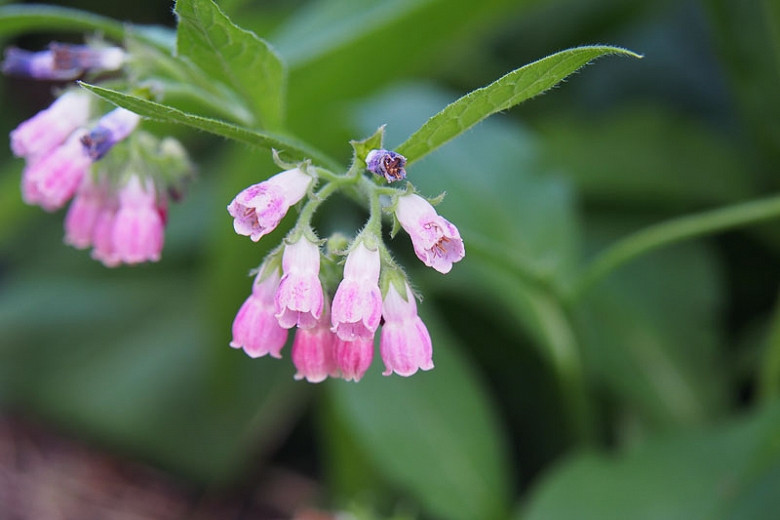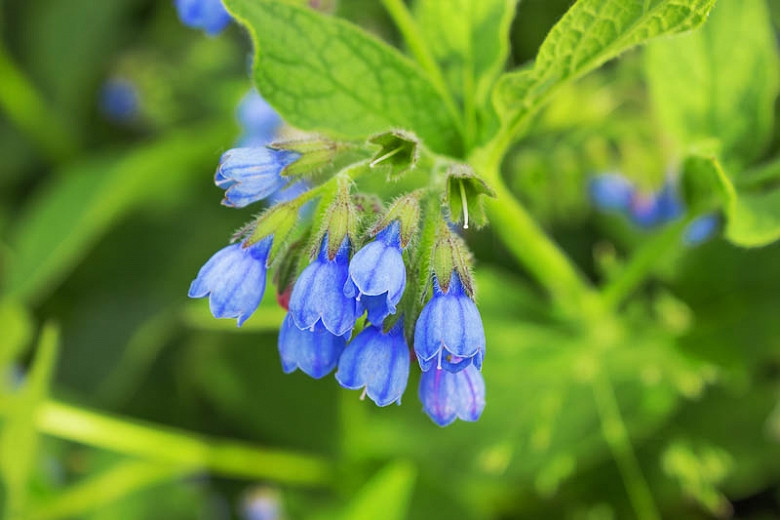Symphytum officinale (Common Comfrey)
Symphytum officinale (Common Comfrey) is a coarse, spreading perennial forming a clump of long, elliptic, dark green leaves, 10 in. long (25 cm). In late spring to early summer, nodding, tubular bell-shaped, purple, pink or cream flowers appear in drooping clusters. Comfrey has a long history as a medicinal herb and has been grown in herbal gardens since the 12th century.
Symphytum officinale (Common Comfrey) is a coarse, spreading perennial forming a clump of long, elliptic, dark green leaves, 10 in. long (25 cm). In late spring to early summer, nodding, tubular bell-shaped, purple, pink or cream flowers appear in drooping clusters. Comfrey has a long history as a medicinal herb and has been grown in herbal gardens since the 12th century. It was used as a poultice to help the healing of broken bones and became known as boneset. Today, it is also used in perennial borders, as a ground cover, or on banks of streams and ponds. A most suitable plant for moist areas in sun or dappled shade.
- Grows up to 1-3 ft. tall (30-90 cm) and 10-30 in. wide (25-75 cm). Because it spreads rapidly, give it some space. Once established, Comfrey can be very difficult to dig out.
- Thrives in full sun or part shade in moderately fertile, moist, well-drained soils. Appreciates some afternoon shade in hot summer climates. Drought tolerant once established.
- Excellent choice for herb gardens, woodland gardens, cottage gardens or wildflower gardens where it can form attractive colonies over time. It makes a good groundcover but can become invasive, so site with care. Planting in containers may help limit its spread.
- Easy to grow, deer-resistant, disease and pest free, clay soil tolerant.
- Cutting back stems promptly after flowering may encourage a possible rebloom and neat, young foliage.
- Propagate by division of fleshy roots in spring. Propagate by root cuttings in early winter. Propagate by seed sown in pots in a cold frame in autumn or spring.
- Ingestion may cause severe discomfort
- Native to Europe, Asia.
- Find where this species is invasive in the United States.
- Discover beautiful U.S. native plant alternatives.
Requirements
| Hardiness | 4 – 8 |
|---|---|
| Climate Zones | 1, 1A, 1B, 2, 2A, 2B, 3, 3A, 3B, 4, 5, 6, 7, 8, 9, 10, 11, 12, 13, 14, 15, 16, 17, 18, 19, 20, 21, 22, 23, 24 |
| Plant Type | Herbs, Perennials |
| Plant Family | Symphytum – Comfrey |
| Exposure | Full Sun, Partial Sun |
| Season of Interest | Spring (Late)Summer (Early) |
| Height | 1' – 3' (30cm – 90cm) |
| Spread | 10" – 3' (25cm – 90cm) |
| Spacing | 24″ (60cm) |
| Water Needs | Average |
| Maintenance | Low |
| Soil Type | Chalk, Clay, Loam, Sand |
| Soil pH | Acid, Alkaline, Neutral |
| Soil Drainage | Moist but Well-Drained, Poorly Drained |
| Characteristics | Showy |
| Native Plants | United Kingdom |
| Tolerance | Clay Soil, Deer, Drought |
| Garden Uses | Ground Covers, Patio and Containers, Underplanting Roses and Shrubs |
| Garden Styles | Informal and Cottage, Prairie and Meadow |


